mybatis源码分析之04Mapper接口的动态代理
在工作中,使用mybatis操作数据库,只需要提供一个接口类,定义一些方法,然后调用接口里面的方法就可以CRUD,感觉是牛了一逼!
该篇就是记录一下,mybatis是如何完成这波骚操作的,即分析我们测试代码的第4行。
FemaleMapper femaleMapper = sqlSession.getMapper(FemaleMapper.class);
由上篇可知,sqlSession的真实类型是DefaultSqlSession. 所以,我们直接是看DefaultSqlSession#getMapper(Class<T> type)方法,当然,断点也是少不了的!
public <T> T getMapper(Class<T> type) {
return configuration.getMapper(type, this);
}
是不是有点熟悉。。。。 接着走。。。
public <T> T getMapper(Class<T> type, SqlSession sqlSession) {
return mapperRegistry.getMapper(type, sqlSession);
}
再接着走。。。。
public <T> T getMapper(Class<T> type, SqlSession sqlSession) {
final MapperProxyFactory<T> mapperProxyFactory = (MapperProxyFactory<T>) knownMappers.get(type);
if (mapperProxyFactory == null) {
throw new BindingException("Type " + type + " is not known to the MapperRegistry.");
}
try {
return mapperProxyFactory.newInstance(sqlSession);
} catch (Exception e) {
throw new BindingException("Error getting mapper instance. Cause: " + e, e);
}
}
看到上面这段代码 ,肯定有反应了。 在上上篇中,我们说到解析xml配置时,会将Mapper接口缓存到MapperRegistry#knownMappers集合中,key是Mapper接口全路径,
Value是该Mapper接口的一个代理工厂类MapperProxyFactory, 源代码就是MapperRegistry#addMapper(Class<T> type)方法,代码如下:
public <T> void addMapper(Class<T> type) {
try {
knownMappers.put(type, new MapperProxyFactory<>(type));
} finally {
}
}
回归正题,此时getMapper()就是根据Mapper接口类型,去knownMappers集合中拿到其对应的代理工厂类。然后通过这个代理工厂类去创建Mapper接口的代理对象。
请看MapperProxyFactory#newInstance(SqlSession sqlSession)方法
public T newInstance(SqlSession sqlSession) {
final MapperProxy<T> mapperProxy = new MapperProxy<>(sqlSession, mapperInterface, methodCache);
return newInstance(mapperProxy);
}
又new了个MapperProxy, 看框架就是麻烦 ,封装了一层又一层, 但是还得看, 因为MapperProxy才是真正干事的!
然后就是下面这个方法,创建代理类
protected T newInstance(MapperProxy<T> mapperProxy) {
return (T) Proxy.newProxyInstance(mapperInterface.getClassLoader(), new Class[] { mapperInterface }, mapperProxy);
}
debug 看一下,感觉不用debug完全活不下去了。。。
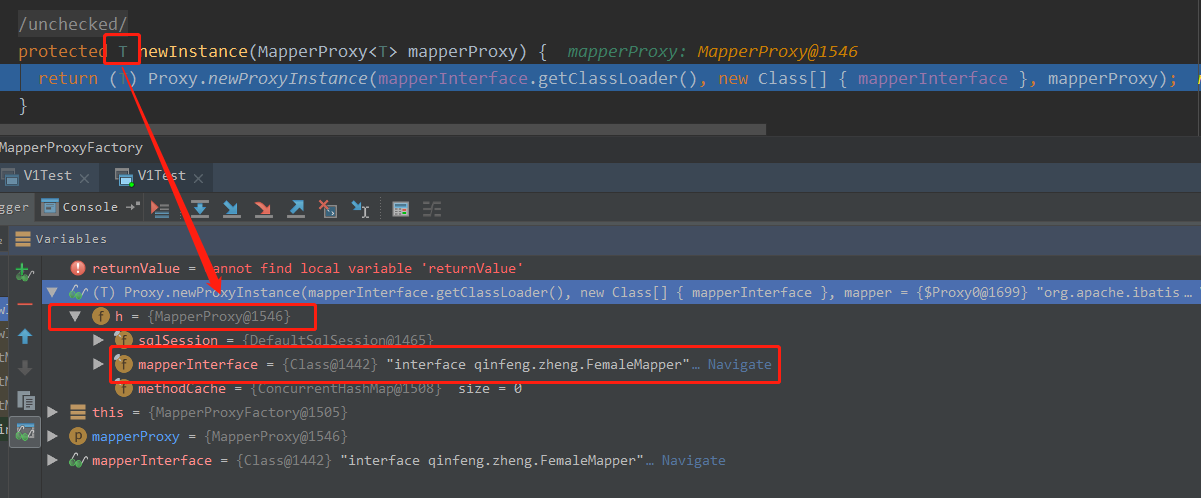
看到没有, 返回的是一个MapperProxy@1546
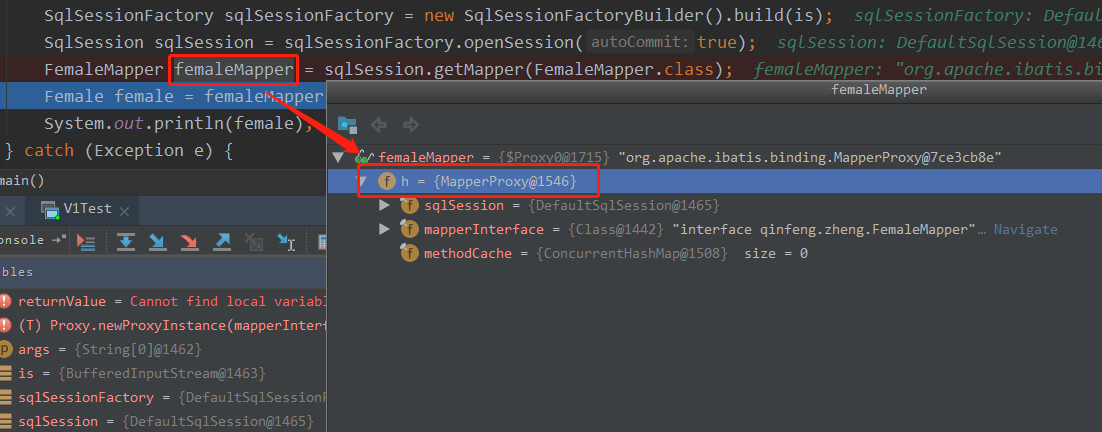
好,测试代码 FemaleMapper femaleMapper = sqlSession.getMapper(FemaleMapper.class) 这一句执行完毕,返回了一个MapperProxy代码对象,即然是代理,那肯定是
要去看看它的invoke()方法了, 这才是重头戏。
而当程序执行 Female female = femaleMapper.getFemaleById(1) 这行代理时,就会调用MapperProxy#invoke()方法。
MapperProxy#invoke()方法,源码如下:
public Object invoke(Object proxy, Method method, Object[] args) throws Throwable {
try {
if (Object.class.equals(method.getDeclaringClass())) {
return method.invoke(this, args);
} else if (method.isDefault()) {
return invokeDefaultMethod(proxy, method, args);
}
} catch (Throwable t) {
throw ExceptionUtil.unwrapThrowable(t);
}
final MapperMethod mapperMethod = cachedMapperMethod(method);
return mapperMethod.execute(sqlSession, args);
}
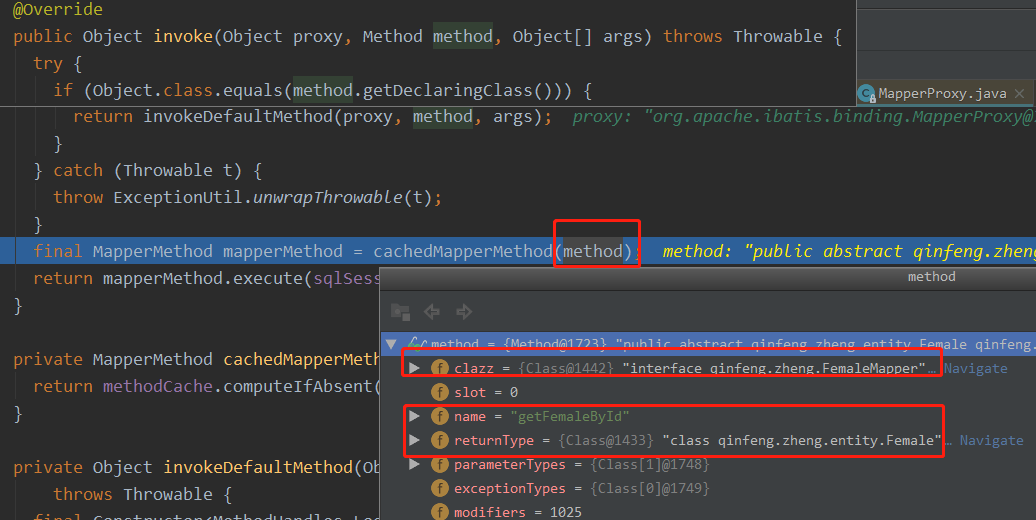
所以,应该去看看cachedMapperMethod(method)在干啥?
private MapperMethod cachedMapperMethod(Method method) {
return methodCache.computeIfAbsent(method, k -> new MapperMethod(mapperInterface, method, sqlSession.getConfiguration()));
}
创建 MapperMethod,并缓存起来,所以说,mybatis也没那么傻,并不是每次都去构造MapperMethod实例 ,这个实例干嘛呢? 接着看!
public MapperMethod(Class<?> mapperInterface, Method method, Configuration config) {
this.command = new SqlCommand(config, mapperInterface, method);
this.method = new MethodSignature(config, mapperInterface, method);
}
这里就不具体说了,代码也很简单。
<1> SqlCommand两个属性,一个name,一个type, debug一下,啥都明白了

<2> MethodSignature 方法签名,就是对方法的返回值判断,还有比如@Param注解等处理。。。

MapperProxy#invoke()方法的最后就是调用MapperMethod#execute(sqlSession,args)方法,该方法最终就是调用Executor类中方法操作数据库。
<1> MapperMethod#execute()
public Object execute(SqlSession sqlSession, Object[] args) {
Object result;
switch (command.getType()) {
case INSERT: {
Object param = method.convertArgsToSqlCommandParam(args);
result = rowCountResult(sqlSession.insert(command.getName(), param));
break;
}
case UPDATE: {
Object param = method.convertArgsToSqlCommandParam(args);
result = rowCountResult(sqlSession.update(command.getName(), param));
break;
}
case DELETE: {
Object param = method.convertArgsToSqlCommandParam(args);
result = rowCountResult(sqlSession.delete(command.getName(), param));
break;
}
case SELECT:
if (method.returnsVoid() && method.hasResultHandler()) {
executeWithResultHandler(sqlSession, args);
result = null;
} else if (method.returnsMany()) {
result = executeForMany(sqlSession, args);
} else if (method.returnsMap()) {
result = executeForMap(sqlSession, args);
} else if (method.returnsCursor()) {
result = executeForCursor(sqlSession, args);
} else {
Object param = method.convertArgsToSqlCommandParam(args);
result = sqlSession.selectOne(command.getName(), param);
if (method.returnsOptional()
&& (result == null || !method.getReturnType().equals(result.getClass()))) {
result = Optional.ofNullable(result);
}
}
break;
case FLUSH:
result = sqlSession.flushStatements();
break;
default:
throw new BindingException("Unknown execution method for: " + command.getName());
}
if (result == null && method.getReturnType().isPrimitive() && !method.returnsVoid()) {
throw new BindingException("Mapper method '" + command.getName()
+ " attempted to return null from a method with a primitive return type (" + method.getReturnType() + ").");
}
return result;
}
该方法就是根据sql的类型,执行具体的逻辑 ,咱们的测试代码是SELECT,所以会走到这儿

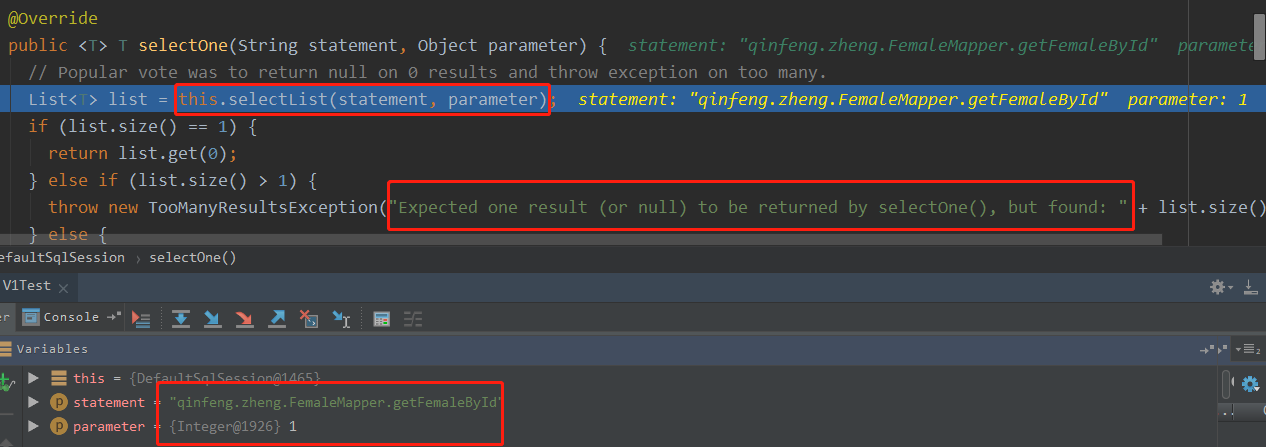
selectOne底层还是调用的selectList,只是取的get(0) , 还有这个异常,工作中也是很常见的呀,原来是这儿抛出来的!
接着看selectList()方法
@Override
public <E> List<E> selectList(String statement, Object parameter) {
return this.selectList(statement, parameter, RowBounds.DEFAULT);
}
RowBounds, mybatis提供的分页功能,不过这里使用的是DEFAULT,即是偏移量是0,limit 是 Integer.MAX_VALUE, 没啥用,如果我们想使用RowBounds分页,传一个自定义的RowBounds对象即可!
一路往前奔。。。 终于来到这儿。。。
@Override
public <E> List<E> selectList(String statement, Object parameter, RowBounds rowBounds) {
try {
MappedStatement ms = configuration.getMappedStatement(statement);
return executor.query(ms, wrapCollection(parameter), rowBounds, Executor.NO_RESULT_HANDLER);
} catch (Exception e) {
throw ExceptionFactory.wrapException("Error querying database. Cause: " + e, e);
} finally {
ErrorContext.instance().reset();
}
}
前文说过,跟数据库sql相关的东西都封装在MappedStatement 对象中,最终操作数据库的都是Executor实例 ,这儿可以得到证明!
到这儿就差不多了,剩下的就是jdbc操作数据库那一套了。
总结:
1. mybatis创建了一个MapperProxy的代理,用于操作Mapper接口的方法,从而做到CRUD, 在此过程中需要用到的一些实例,前期都已经准备好了!
2. 流程图
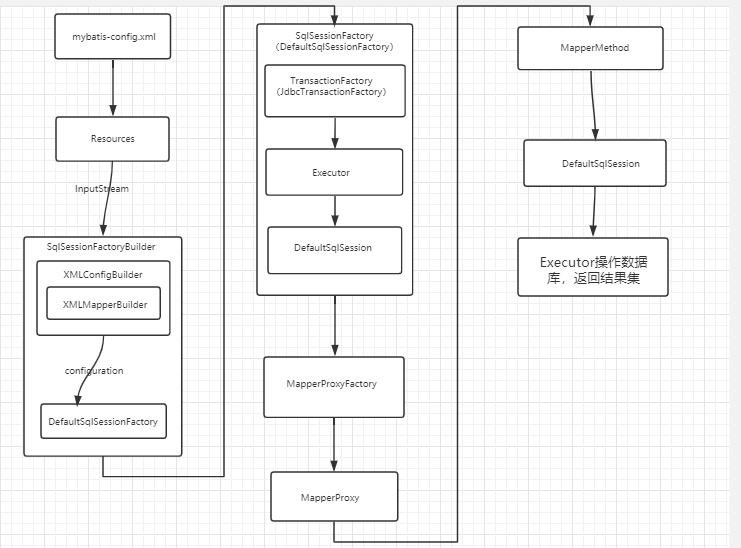
最新文章
- Impress.js上手 - 抛开PPT、制作Web 3D幻灯片放映
- 高仿ios版美团框架项目源码
- 解决SprngMVC中ResponseBody注解中文乱码
- Android 使用Application类保存应用的全局数据
- T-SQL备忘(5):查看执行计划
- VTK序列图像的读取[转][改]
- 进程间通信和同步:pipe、FIFO、消息队列、信号量、共享内存、信号
- 为什么不使用frame框架的原因
- CocoaPods 报错 [!] Error installing JSONModel
- cf1000F One Occurrence (线段树)
- Storm基本原理概念及基本使用
- day05 判断敏感字符
- Android 获取网络类型
- Word不能添加目录?
- Vue小案例 之 商品管理------创建页面与部分数据
- 20165205 《Java程序设计》第一周学习总结
- 【Java】Java-正则匹配-性能优化
- 关于while(cin>>c)语句的理解
- Warning: Attempt to present A on B whose view is not in the window hierarchy!
- 数据结构编程实验——chapter8-采用树结构的非线性表编程